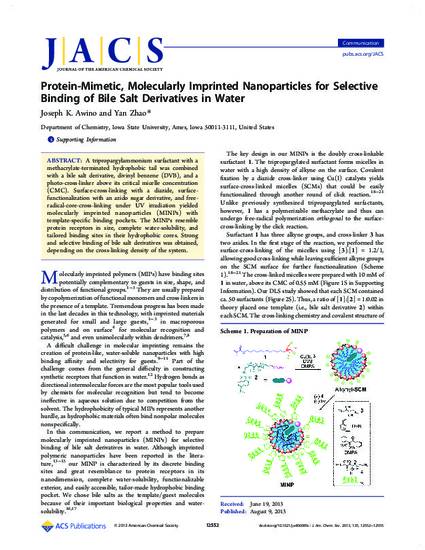
Article
Protein-Mimetic, Molecularly Imprinted Nanoparticles for Selective Binding of Bile Salt Derivatives in Water
Journal of the American Chemical Society
Document Type
Article
Disciplines
Publication Version
Published Version
Publication Date
8-1-2013
DOI
10.1021/ja406089c
Abstract
A tripropargylammonium surfactant with a methacrylate-terminated hydrophobic tail was combined with a bile salt derivative, divinyl benzene (DVB), and a photo-cross-linker above its critical micelle concentration (CMC). Surface-cross-linking with a diazide, surface-functionalization with an azido sugar derivative, and free-radical-core-cross-linking under UV irradiation yielded molecularly imprinted nanoparticles (MINPs) with template-specific binding pockets. The MINPs resemble protein receptors in size, complete water-solubility, and tailored binding sites in their hydrophobic cores. Strong and selective binding of bile salt derivatives was obtained, depending on the cross-linking density of the system.
Copyright Owner
American Chemical Society
Copyright Date
2013
Language
en
File Format
application/pdf
Citation Information
Joseph K. Awino and Yan Zhao. "Protein-Mimetic, Molecularly Imprinted Nanoparticles for Selective Binding of Bile Salt Derivatives in Water" Journal of the American Chemical Society Vol. 135 Iss. 34 (2013) p. 12552 - 12555 Available at: http://works.bepress.com/yan_zhao/3/

Reprinted (adapted) with permission from Journal of the American Chemical Society 135 (2013): 12552, doi:10.1021/ja406089c. Copyright 2013 American Chemical Society.